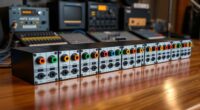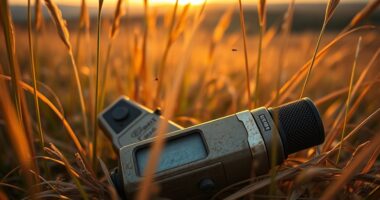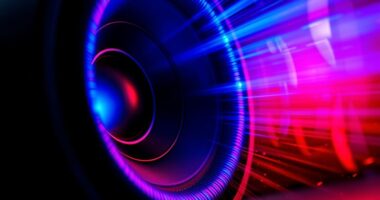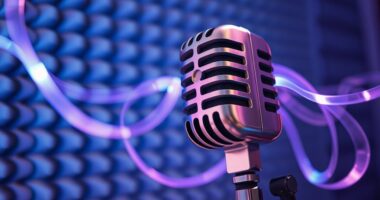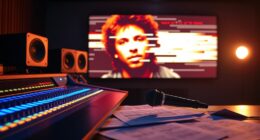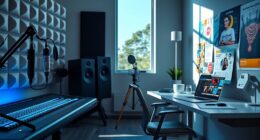To decrease the noise floor without losing your audio’s energy, start with proper microphone placement and acoustic treatments to minimize ambient noise upfront. Use adaptive noise reduction tools carefully—set thresholds just above the noise level to avoid dulling the natural sparkle of your sound. Applying precise equalization and filtering helps target problematic frequencies without affecting clarity. For best results, balancing these techniques ensures silence while keeping your audio lively; discover how these strategies combine for ideal sound quality.
Key Takeaways
- Use adaptive noise reduction algorithms that target noise without affecting the desired audio details.
- Employ directional microphones and proper placement to minimize ambient noise upfront.
- Apply frequency-specific filters, like notch filters, to remove persistent hums without dulling the main sound.
- Adjust noise gate settings carefully to suppress background noise while preserving quiet, natural sounds.
- Monitor in real-time to fine-tune noise reduction parameters, avoiding over-processing that diminishes audio sparkle.
Understanding the Noise Floor and Its Impact on Audio Quality
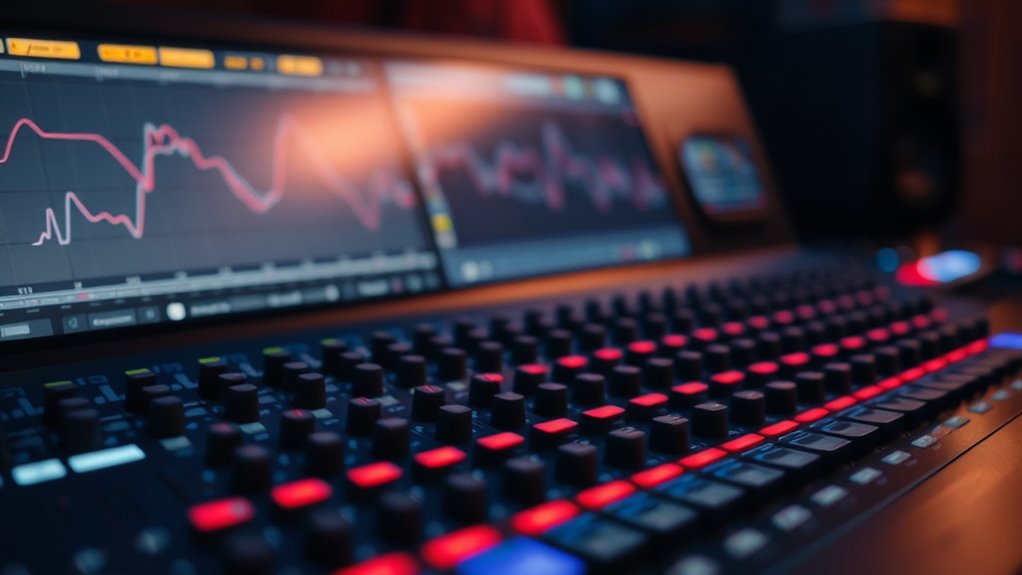
The noise floor is the baseline level of background noise present in any audio system, and understanding it is essential for achieving high-quality sound. When you know your noise floor, you can better identify unwanted sounds that interfere with your audio. It’s the subtle hum, hiss, or static that’s always there, even when no intentional sound is playing. If your noise floor is too high, it can mask quiet parts of your audio, making details hard to hear. This impacts clarity and overall quality. Recognizing the noise floor helps you decide when noise reduction is necessary. It also guides you in choosing equipment and settings that minimize background noise and signal-to-noise ratio, ensuring your recordings or playback sound clean, crisp, and professional. Additionally, understanding your system’s dynamic range allows for optimal balancing between loud and quiet sounds without distortion. Being aware of your noise floor can also help you troubleshoot issues and improve your overall audio setup. Knowing how to measure noise floor accurately can lead to better calibration and improved sound performance.
Identifying When Noise Reduction Is Necessary

Recognizing when noise reduction is necessary depends on listening carefully to your audio. If you notice hissing, buzzing, or background hum that distracts from the main sound, it’s a sign noise reduction could help. Pay attention to subtle background sounds that weren’t there originally, which may indicate unwanted noise. When these noises become more prominent during quiet sections or pauses, it’s a clear cue. Also, if your audio sounds muffled or cluttered, reducing the noise floor can clarify your recordings. However, if your sound is clean and free of distracting background or ambient noise, additional noise reduction might not be needed. Trust your ears—if unwanted noise diminishes your audio’s clarity or professionalism, it’s a time to contemplate noise reduction techniques. Additionally, understanding the noise floor in your recordings can help you determine whether noise reduction is truly necessary. Being aware of the background noise levels can prevent over-processing that might degrade audio quality. Moreover, knowledge of the fetal development stages can assist in assessing the overall quality of your audio recordings, ensuring clarity during critical moments. Understanding the filtration technology used in devices can also inform your decision about when noise reduction is most beneficial.
Essential Tools and Software for Noise Floor Management
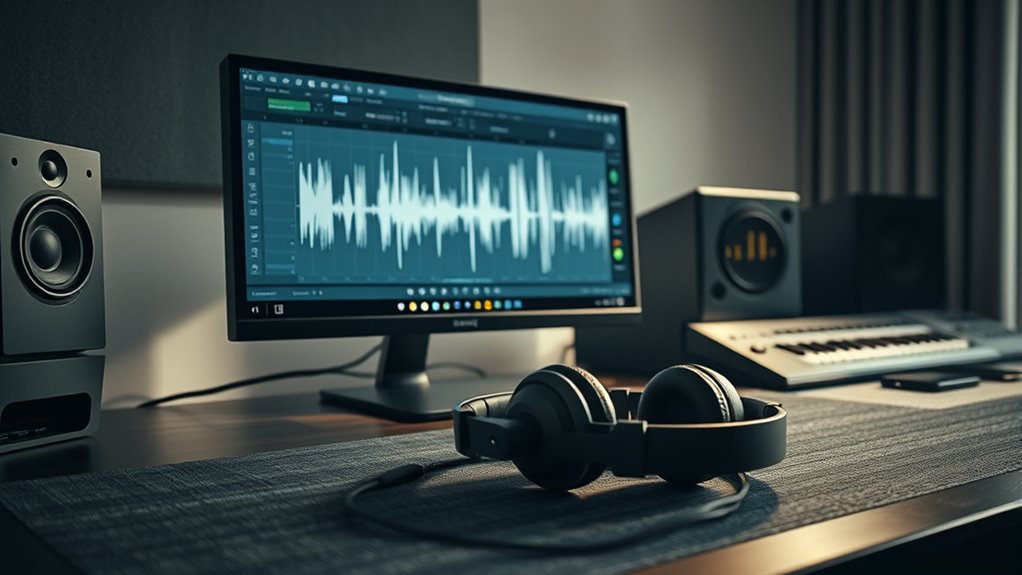
To effectively manage the noise floor, you need the right tools and software. Sound level meters and analyzers help you measure and identify problem areas accurately. Noise gate and suppressor software then allow you to control and reduce unwanted background sounds efficiently. Implementing data-driven strategies can further optimize noise reduction results. Data-driven strategies enable precise adjustments and measurable improvements in noise management. Additionally, understanding privacy policies related to your noise reduction tools ensures responsible data handling and compliance. Incorporating remote work considerations can help tailor noise management solutions to different environments and schedules.
Sound Level Meters and Analyzers
Sound level meters and analyzers are essential tools for accurately measuring and managing noise floors in various environments. They allow you to precisely monitor sound levels, helping you identify unwanted background noise that can interfere with audio clarity or cause disturbances. Modern sound level meters provide real-time readings and data logging capabilities, enabling you to track fluctuations over time. Analyzers go a step further by breaking down sound into frequency components, giving you insight into specific noise sources. With these tools, you can set benchmarks, ensure compliance with regulations, and fine-tune your audio environment. Whether you’re in a recording studio, industrial space, or public venue, having reliable measurement equipment guarantees you maintain peak noise levels without sacrificing audio quality or comfort. Additionally, understanding the noise floor helps in designing spaces that optimize acoustic performance and minimize unwanted sound interference. Knowing how to interpret sound level data is crucial for effective noise management and ensuring a balanced acoustic environment. Leveraging AI-powered analytics can further enhance your ability to analyze complex sound environments and optimize noise control strategies, especially when integrated with compliance standards to meet legal requirements.
Noise Gate and Suppressor Software
Noise gate and suppressor software are powerful tools for controlling and reducing unwanted background noise in audio recordings and live sound setups. They work by automatically cutting off sound below a set threshold, eliminating hums, hisses, or ambient noise when you’re not speaking or playing. You can adjust the threshold, attack, and release times to match your environment, ensuring natural sound without abrupt cuts. These tools are especially useful in home studios, podcasts, and live performances where background noise can be distracting. Many software options integrate seamlessly with digital audio workstations (DAWs) or operate as standalone plugins. By fine-tuning these settings, you maintain clarity and preserve the desired audio spark while effectively managing the noise floor. Understanding the importance of empathy and awareness in audio management can help you better recognize and troubleshoot issues related to background noise and its impact on overall sound quality.
Techniques for Effective Noise Suppression Without Dulling Clarity
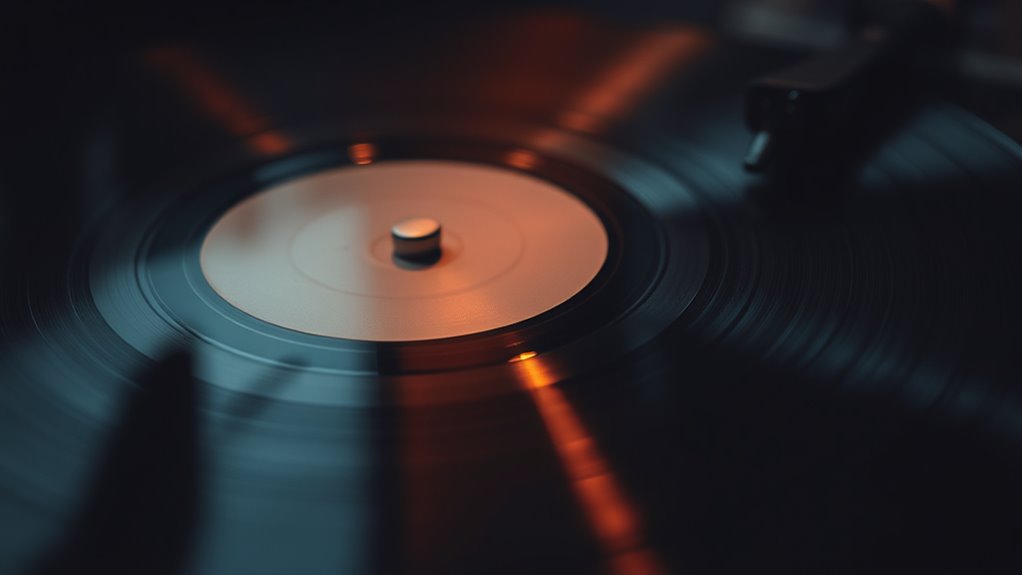
Achieving effective noise suppression without sacrificing audio clarity requires a careful balance of techniques that target unwanted sounds while preserving the integrity of the original signal. One approach is to use directional microphones that minimize background noise by focusing on your source. Additionally, employing adaptive noise reduction algorithms can dynamically differentiate between noise and desired audio, reducing interference without dulling detail. Proper placement of microphones and using acoustic treatments help reduce ambient noise upfront. You can also implement real-time monitoring to fine-tune noise suppression settings, ensuring clarity remains intact. Keep in mind that over-aggressive noise reduction can cause audio artifacts or a hollow sound, so always aim for subtle, targeted adjustments. Being aware of noise floor reduction techniques can further enhance the clarity of your audio by lowering the background noise level without compromising the main signal. These strategies help maintain a natural, clear sound while keeping background noise at bay.
The Role of Equalization and Filtering in Noise Control
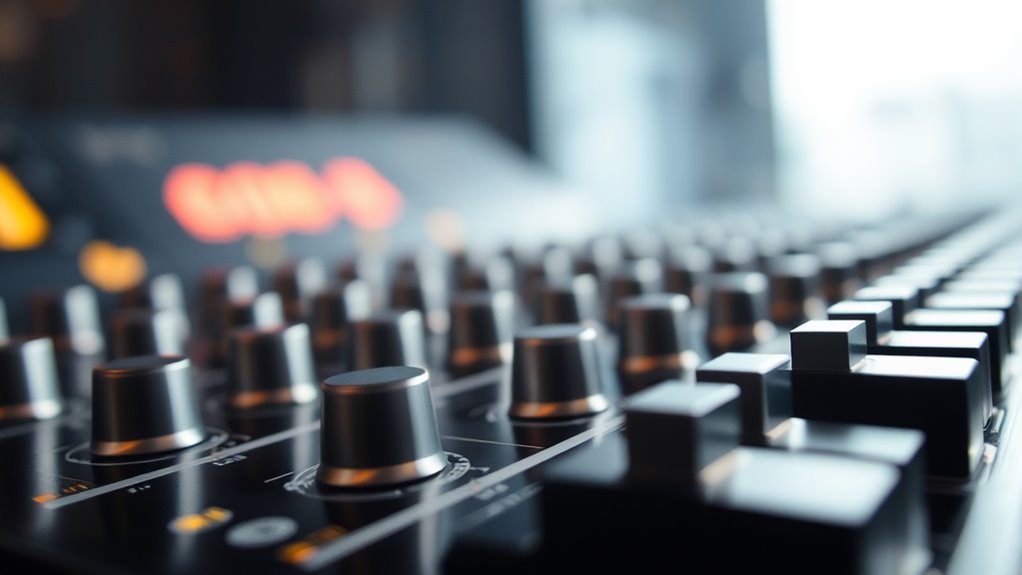
Equalization and filtering are powerful tools for shaping the frequency spectrum to reduce noise. By using notch and bandpass filters, you can target specific unwanted frequencies without affecting the overall sound quality. Understanding how to apply these techniques helps you control noise while preserving clarity. Incorporating space optimization strategies can further enhance your environment by reducing acoustic clutter and echoes.
Frequency Spectrum Shaping
Frequency spectrum shaping plays a crucial role in noise control by targeting specific parts of the audio range to reduce unwanted sounds. By adjusting the amplitude of certain frequencies, you can diminish persistent hums, hisses, or background noise without affecting the overall audio quality. Equalizers and filters allow you to emphasize desired sounds while suppressing problematic frequencies. This process helps you create a clearer, cleaner sound environment, especially in recordings or live settings. Proper spectrum shaping ensures that noise is minimized where it’s most intrusive, making speech or music more intelligible and pleasant. When applied carefully, it prevents noise from overpowering the main audio signals, maintaining the integrity of your sound while reducing unwanted interference.
Notch and Bandpass Filters
Have you ever needed to isolate or eliminate a specific noise in your audio? Notch and bandpass filters help you do that precisely. A notch filter targets a narrow frequency, removing unwanted sounds like hums or squeals, while a bandpass filter isolates a specific range, emphasizing or reducing certain signals. Use a notch filter when you want to eliminate a single problematic frequency without affecting others. A bandpass filter is ideal for highlighting or suppressing a specific frequency band. Here’s a quick overview:
| Filter Type | Purpose | Use Case |
|---|---|---|
| Notch Filter | Remove narrow unwanted tones | Eliminating electrical hum (e.g., 60Hz) |
| Bandpass Filter | Isolate specific frequency range | Focusing on vocal or instrument frequencies |
| Both | Precise noise control | Reducing noise without affecting overall audio |
Equalization Techniques
While filters like notch and bandpass are effective for targeting specific noise, equalization techniques play a crucial role in shaping the overall sound and controlling unwanted noise across broader frequency ranges. By adjusting the frequency response, you can reduce hums, hisses, or rumble without sacrificing audio quality. Equalizers let you emphasize desired sounds and diminish distracting ones simultaneously. Proper use involves identifying problematic frequencies and applying targeted cuts or boosts. This approach ensures your audio remains clear and balanced, even amid background noise. Remember, subtle adjustments often make the biggest difference. When used correctly, equalization enhances clarity without sacrificing the natural tone of your recording. It’s a flexible, powerful tool for noise control that complements filtering techniques seamlessly.
- Identify problematic frequency ranges
- Make precise cuts or boosts
- Maintain natural sound quality
- Achieve balanced audio clarity
Dynamic Range Optimization to Preserve Audio Vitality
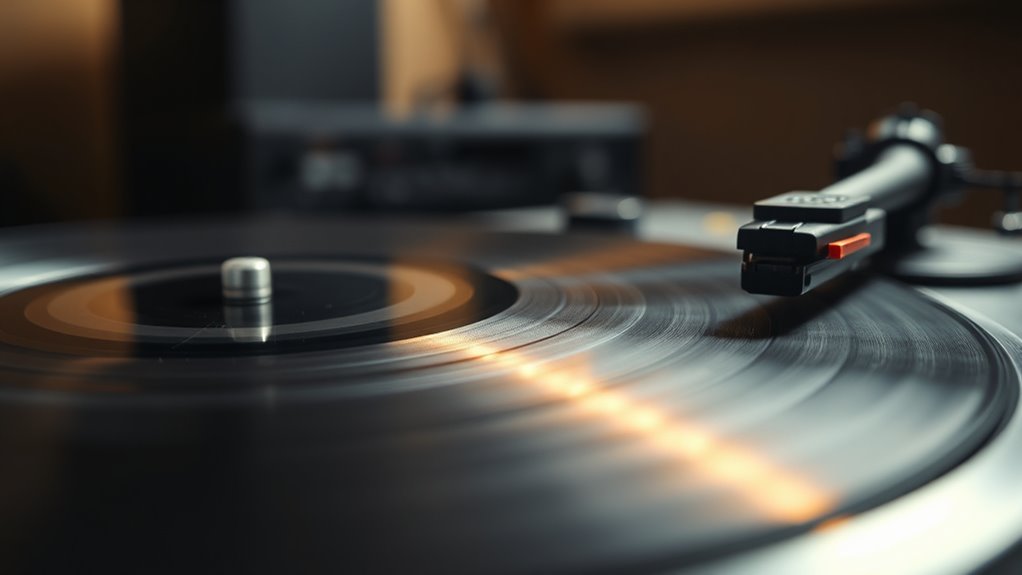
To effectively reduce the noise floor without sacrificing the clarity and impact of your audio, you need to optimize the dynamic range. This means balancing the loud and soft parts so that quieter sounds aren’t drowned out by background noise, but peaks remain powerful. Use compression carefully to tame excessive volume differences without flattening the audio’s vitality. Set the threshold where only the loudest signals are affected, preserving natural dynamics. Adjust the ratio to guarantee smooth transitions, avoiding a squashed sound. Incorporate limiting to prevent clipping on peaks, maintaining clarity. Ultimately, dynamic range optimization helps you retain the energy and emotion of your audio while keeping noise at bay, ensuring your recordings sound lively and professional without unwanted background interference.
Practical Tips for Live Recordings and Post-Production

When working with live recordings, capturing clean audio requires proactive planning and quick adjustments. You should choose the right environment, set appropriate levels, and monitor sound in real-time. During recording, keep an eye on background noise and use directional microphones to minimize unwanted sounds. If noise persists, consider employing gating or manual editing to reduce it without affecting performance. In post-production, focus on gentle noise reduction techniques, avoiding overprocessing that can dull the audio’s clarity. Carefully analyze the noise profile and apply targeted filters. Always balance noise reduction with preserving the natural ambiance and energy of the performance.
Key tips include:
- Use quality microphones and proper placement
- Monitor audio levels constantly during recording
- Apply real-time noise suppression tools cautiously
- Edit with precision, avoiding over-filtering
Balancing Noise Reduction and Audio Engagement: Best Practices
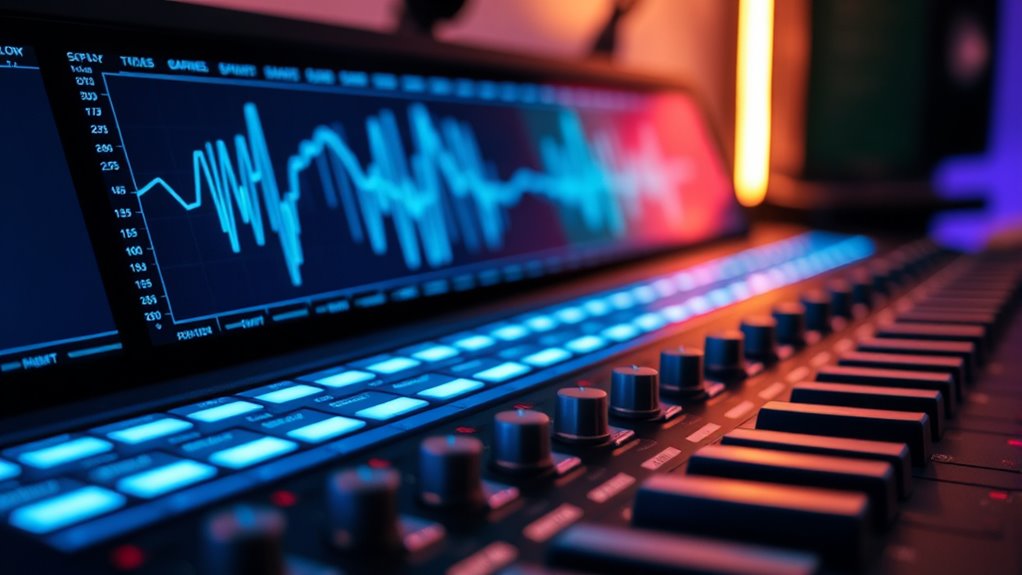
Balancing noise reduction with maintaining audio engagement is essential to guarantee your recordings sound professional and lively. To achieve this, start by applying noise reduction subtly, focusing on eliminating only the most distracting background sounds. Use visual meters and listen carefully to avoid over-processing that can dull the audio or introduce artifacts. Keep your audience engaged by preserving dynamic range and clarity, ensuring speech remains natural. Implement multi-band noise reduction techniques to target specific frequencies without affecting the overall tone. Always compare your processed audio with the original to ensure you haven’t compromised intelligibility or energy. Regularly adjust settings based on the content and environment, and remember: less is often more when it comes to noise reduction.
Frequently Asked Questions
How Does Ambient Environment Affect the Noise Floor in Recordings?
Ambient environment plays a vital role in your recordings by influencing the noise floor. If you’re in a noisy space, background sounds like hums, traffic, or electronics can raise the noise floor, making quiet details hard to hear. Conversely, a controlled environment with minimal background noise helps you capture cleaner, clearer recordings. You should choose a quiet, treated space to reduce ambient noise and improve overall sound quality.
Can Noise Reduction Techniques Cause Unintended Audio Artifacts?
You might worry that noise reduction techniques cause unwanted artifacts, and that’s a real concern. When you apply these methods, especially aggressive ones, they can introduce artifacts like echoes, swirls, or unnatural sounds. To avoid this, you should use subtle settings and listen carefully. Balancing noise reduction with preserving audio quality helps maintain clarity without sacrificing the natural sparkle of your recordings.
What Are the Best Practices for Real-Time Noise Management During Live Sessions?
During live sessions, you should prioritize adaptive noise management. Use real-time noise suppression tools that adjust dynamically to changing sounds, ensuring clear audio without over-suppressing. Always monitor audio levels, and set thresholds carefully to avoid cutting out important sounds. Incorporate filters selectively, and test your setup beforehand. Remember, balance is key—aim to reduce background noise while maintaining the natural quality and energy of your session.
How Do Different Microphone Types Influence the Noise Floor?
Did you know that condenser microphones tend to have a noise floor up to 20 dB higher than dynamic microphones? Different microphone types greatly impact your noise floor. Condensers are more sensitive and pick up more ambient noise, making them ideal for studio use but challenging in noisy environments. Dynamic mics are less sensitive, helping you keep background noise low, perfect for live settings where clarity is key.
Is There a Risk of Over-Processing and Losing Audio Authenticity?
You might worry about over-processing audio and losing authenticity. While noise reduction tools can improve clarity, overdoing them risks removing natural textures and making your sound flat or artificial. To avoid this, balance is key. Use gentle settings, listen critically, and compare processed audio to the original. This way, you preserve the essence of the performance while reducing unwanted noise, maintaining both clarity and authenticity.
Conclusion
By understanding and managing the noise floor effectively, you can achieve silence without sacrificing the spark of your audio. With the right tools and techniques, you’re in control of clarity and engagement. Are you ready to elevate your recordings and make noise reduction work for you, not against you? Remember, the goal isn’t just quiet—it’s about preserving the liveliness that makes your sound truly stand out.

